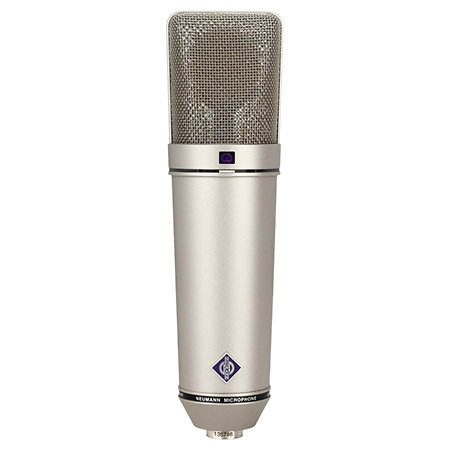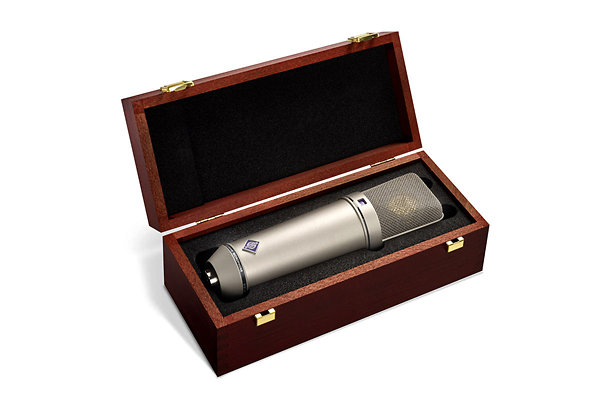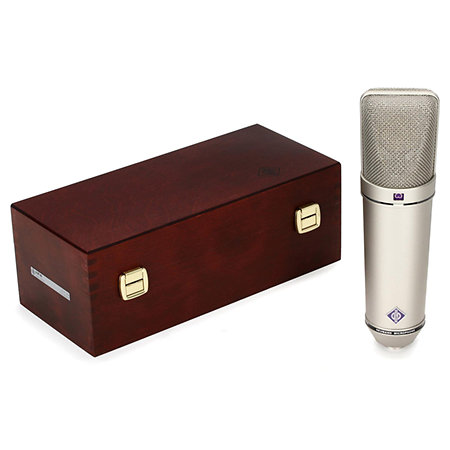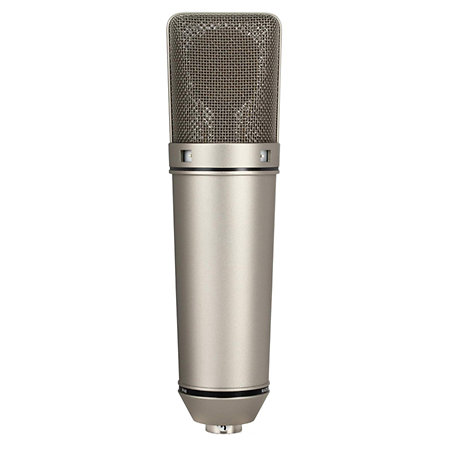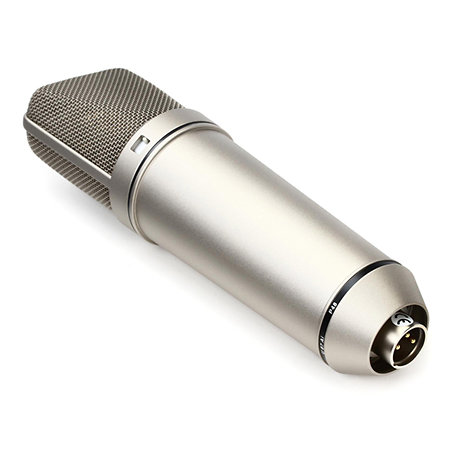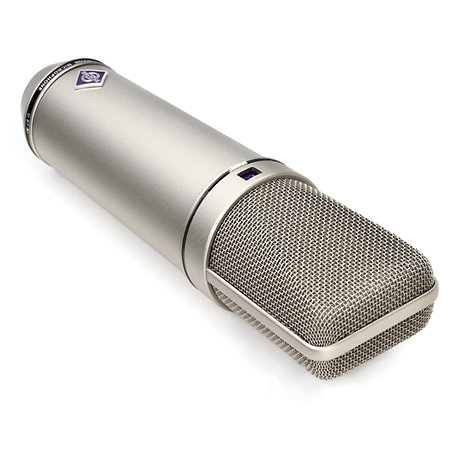Neumann - U 87 Ai Ni
2 404,17 €
excl VAT
with eco participation: 0,07 €
Out of stock
Contact us for delivery times
Warranty 3 years
Static Microphone
THE classic Neumann U87Ai model. Its three switchable attenuator and its suitability for a wide variety of applications.
ARTICLE N° 9274
Specifications
-
Neumann U87Ai
-
Acoustic operating principle Pressure gradient transducer
-
Omnidirectional, cardioid, (Figure 8)
-
Frequency response 20 Hz to 20 kHz
-
Sensitivity at 1 kHz into 1 kohm 20/28/22 mV / Pa *
-
Rated impedance 200 Ohms
-
Recommended Load Impedance 1 kOhm
-
Noise level reduced to the entrance, according to CCIR 468-3 26/23/25 dB *
-
Reduced noise level to entry, DIN / IEC 651 12/15/14 dB-A *
-
Report Signal / Noise according to CCIR 468-3 68/71/69 dB *
-
Signal / Noise Ratio, according to DIN / IEC 651 79/82/80 dB *
-
Maximum SPL for THD = 0.5% 117 dB (cardioid)
-
Maximum SPL for THD = 0.5%, pre-activated 127 dB attenuator
-
Maximum output of 390 mV Tension
-
Dynamic range of the microphone amplifier (cardioid position), according to DIN / IEC 651 105 - dB
-
Ghost Supply voltage 48 V ± 4 V
-
Current consumption 0.8 mA
-
Output connector XLR 3M
-
Weight 500 g
-
Diameter 56 mm
-
Length 200 mm
-
* Omnidirectional / Cardioid / bi
Presentation
The U 87 is probably the Neumann studio microphone best known and most used in the world. It has a capsule large dual-diaphragm with three directional patterns: omnidirectional, cardioid and bidirectional (figure-8), selectable via a switch located under the grid
Information
Capsule type
Capacitor
Application
Singing, Acoustic guitar, Drum / percussions, Speaking voice, Guitar / bass amplifier
Directivity
Cardioid, Bidirectional (Figure-8), Omnidirectional
Switchable pad
Yes
Switchable Bass-Cut filter
Yes
Shockmount included
No
Power supply
Via +48 V phantom power supply
Color
Nickel
Connectors
XLR male 3 pins
Packaging
Single unit
To go further...
The U 87 is probably the Neumann studio microphone best known and most used in the world. It has a capsule large dual-diaphragm with three directional patterns: omnidirectional, cardioid and bidirectional (figure-8), selectable via a switch located under the grid.
An attenuation of 10 dB selector is located on the rear of the microphone; it allows him to cash undistorted sound pressure levels up to 127 dB SPL.
You can also reduce the bass response to compensate for proximity effect.
Applications
The condenser microphone U 87 Ai is a model membrane of large diameter, with three different directivity, and with unique characteristics in terms of frequency response and transient.
Users immediately recognize this microphone thanks to its very special look. It is a good choice for most common applications in studio, broadcast, film, television ...
The U 87 Ai is also used as a main microphone for orchestra recordings, extra on isolated instruments, and most common way, as micro voice on all types of music (singing) and spoken voice.
Acoustic characteristics
The U 87 Ai is a side-effect model - the Neumann logo is placed facing the sound source. For cardioid and bidirectional, the frequency response is very flat for frontal sound incidence, even in the treble. The microphone can be placed very close to a sound source, without becoming aggressive. His high pass filter attenuates with remarkable efficiency, subsonic interference in the matter.
Directional
The double diaphragm capsule is elastically mounted and protected by a grid of large dimensions. The selector placed under the grid allows to choose between the three directional patterns: omnidirectional, cardioid and biddirectionnelle (Figure 8). The directivity corresponding to the selected icon is displayed in a small window above the dial.
Electrical Characteristics
The letter A from the reference indicates a newer generation compared to the U 87 i models manufactured from 1967 to 1986. The changes concern only the electronic components of the microphone: the capsule itself remained unchanged.
The current system increases the operational headroom of the U 87 Ai by passing the capsule bias voltages by a lower resistance value. The result: increased sensitivity of 10 dB for the same level of sound pressure and a report signal / noise by 3 dB higher.
Filter and attenuation
A selector located on the rear of the microphone reduces sensitivity of 10 dB. When activated, the microphone accepts sound pressure levels up to 127 dB (equivalent figure to a sound pressure of 45 Pa) without distortion.
Another switch at the rear allows to change the microphone's cutoff frequency. It reduces harmful interference directly at the input of the integrated microphone preamplifier.
This switch also compensates the inevitable boost in the bass, common to all pressure gradient transducers when used in small distance from the sound source (proximity effect).
The cardioid frequency response remains flat up to a distance of 30-40 cm - 15 to 20 cm for bidirectional directivity
An attenuation of 10 dB selector is located on the rear of the microphone; it allows him to cash undistorted sound pressure levels up to 127 dB SPL.
You can also reduce the bass response to compensate for proximity effect.
Applications
The condenser microphone U 87 Ai is a model membrane of large diameter, with three different directivity, and with unique characteristics in terms of frequency response and transient.
Users immediately recognize this microphone thanks to its very special look. It is a good choice for most common applications in studio, broadcast, film, television ...
The U 87 Ai is also used as a main microphone for orchestra recordings, extra on isolated instruments, and most common way, as micro voice on all types of music (singing) and spoken voice.
Acoustic characteristics
The U 87 Ai is a side-effect model - the Neumann logo is placed facing the sound source. For cardioid and bidirectional, the frequency response is very flat for frontal sound incidence, even in the treble. The microphone can be placed very close to a sound source, without becoming aggressive. His high pass filter attenuates with remarkable efficiency, subsonic interference in the matter.
Directional
The double diaphragm capsule is elastically mounted and protected by a grid of large dimensions. The selector placed under the grid allows to choose between the three directional patterns: omnidirectional, cardioid and biddirectionnelle (Figure 8). The directivity corresponding to the selected icon is displayed in a small window above the dial.
Electrical Characteristics
The letter A from the reference indicates a newer generation compared to the U 87 i models manufactured from 1967 to 1986. The changes concern only the electronic components of the microphone: the capsule itself remained unchanged.
The current system increases the operational headroom of the U 87 Ai by passing the capsule bias voltages by a lower resistance value. The result: increased sensitivity of 10 dB for the same level of sound pressure and a report signal / noise by 3 dB higher.
Filter and attenuation
A selector located on the rear of the microphone reduces sensitivity of 10 dB. When activated, the microphone accepts sound pressure levels up to 127 dB (equivalent figure to a sound pressure of 45 Pa) without distortion.
Another switch at the rear allows to change the microphone's cutoff frequency. It reduces harmful interference directly at the input of the integrated microphone preamplifier.
This switch also compensates the inevitable boost in the bass, common to all pressure gradient transducers when used in small distance from the sound source (proximity effect).
The cardioid frequency response remains flat up to a distance of 30-40 cm - 15 to 20 cm for bidirectional directivity
You may also like
Neumann - U 87 Ai Ni
Neumann - U 87 Ai Ni
2 404,17 €
excl VAT
with eco participation: 0,07 €
Out of stock
Contact us for delivery times
Warranty 3 years
Spotlight on
A legendary brand for decades, present in all the major recording studios, Neumann is a guarantee of high quality and professionalism. The Beatles, Natalie Cole, Celine Dion, Bryan Adams and Beyoncé... all use this exceptional brand with the famous U87, and the TLM49 at the top of the list. In home studio, the TLM103 and TLM102 condenser microphones are the most popular. For studio sound on stage opt for the KMS105. In recent years, Neumann has also offered the high-end KH80, KH120 and KH310 monitors.


